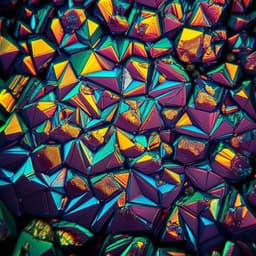
Physics
Large area single crystal gold of single nanometer thickness for nanophotonics
C. Pan, Y. Tong, et al.
This groundbreaking research led by Chenxinyu Pan and colleagues showcases the fabrication of large-area single-crystal two-dimensional gold flakes. These ultrathin flakes, just a nanometer thick, exhibit unprecedented optical nonlinearity and hold immense potential for next-generation nanophotonic applications. Incredibly, they outshine their thicker counterparts in harmonic generation by over two orders of magnitude.
Playback language: English
Introduction
Low-dimensional metals, particularly ultrathin two-dimensional (2D) gold, have garnered significant research interest due to their unique physical, chemical, and mechanical properties stemming from their reduced dimensionality. Ultrathin 2D gold combines quantum effects in its electrical and optical properties, plasmon-enabled extreme light confinement, high optical transparency, and excellent chemical stability. These properties are highly desirable for enhancing light-matter interaction at the nanoscale, crucial for advancing nanophotonics and realizing next-generation ultrathin plasmonic, optoelectronic, photonic, and quantum devices. Existing fabrication methods, including various wet-chemical approaches and deposition techniques using adhesive/seeding layers, face challenges. Wet-chemical methods struggle to produce ultrathin 2D gold with large areas, typically yielding sub-micrometer sizes at sub-5 nm thicknesses. Precise thickness control is also difficult, yet crucial due to the high sensitivity of the material's properties to thickness variations. Deposition approaches, while capable of producing ultrathin films, often result in granular polycrystalline structures that negatively impact performance due to increased electron scattering losses. Furthermore, these films are often difficult to detach from the substrate, limiting their flexibility for integration with other structures and devices. This research addresses these limitations by introducing a novel fabrication method to overcome the challenges of existing approaches.
Literature Review
The existing literature extensively covers the synthesis and characterization of 2D gold nanostructures. Several wet-chemical methods have been developed, including seed-mediated synthesis, polyol reduction, template-directed synthesis, and methyl orange-assisted synthesis, to achieve high crystalline quality and sub-nanometer thicknesses. However, a common limitation is the inverse relationship between thickness and lateral size – thinner films are invariably smaller. Precise thickness control also remains a challenge. Other approaches, such as deposition methods using adhesive/seeding layers (metals or organosilane monolayers), have been explored to produce ultrathin gold films; however, these methods yield polycrystalline structures with surface roughness and grain boundaries that hinder device performance and limit their integration potential. The lack of large-area, single-crystal, ultrathin gold structures with precise thickness control has been a significant barrier to advancing nanophotonics and related fields. This research aims to fill this gap by developing a new fabrication technique that addresses these limitations.
Methodology
This study introduces an atomic-level precision etching (ALPE) approach for fabricating large-area single-crystal 2D gold flakes (2DGFs). The process begins with the synthesis of large-area single-crystal gold flakes (tens of nanometers thick) on a substrate like mica. These flakes are then immersed in a cysteamine solution (200 mM in chloroform; chloroform is used instead of water to enable uniform and controllable etching over large areas). Cysteamine radicals, produced by the reaction of cysteamines with dissolved oxygen, etch the gold atoms via an oxidation-reduction process, forming soluble gold-thiolate complexes. The single-crystal nature of the flakes allows for layer-by-layer etching, resulting in 2DGFs with precisely controlled thickness. The etching rate is approximately 0.2 nm/min and depends on cysteamine concentration. The lateral size of the 2DGFs is determined by the initial size of the gold flakes, reaching sizes up to hundreds of micrometers. The ALPE approach is also adaptable for spatial localization, enabling the creation of micro/nanostructures via localized etching. Techniques such as atomic force microscopy (AFM) and transmission electron microscopy (TEM) were used to characterize the surface morphology and crystalline structure. A four-probe method based on a Hall-bar structure was employed to investigate the electrical properties. Optical techniques were used to analyze linear and nonlinear optical properties, including transmittance, reflectance, second-harmonic generation (SHG), third-harmonic generation (THG), and multiphoton photoluminescence (MPPL). Numerical simulations based on quantum electrostatic models were conducted to understand the observed nonlinear optical responses. Finally, the feasibility of creating low-loss plasmonic nanostructures was demonstrated by patterning 2DGFs into nanoribbon arrays using localized etching, followed by optical characterization and numerical simulations to analyze their plasmonic behavior.
Key Findings
The ALPE method successfully produced large-area (>10<sup>4</sup> μm<sup>2</sup>), single-crystal 2DGFs with thicknesses down to a single nanometer. AFM revealed a smooth surface with an RMS roughness of ~0.25 nm. TEM confirmed the single-crystal hexagonal close-packed structure with a <0001> crystal orientation. The sheet resistance of 2DGFs increased with decreasing thickness, but significantly less than that of sputtered gold films, showcasing the advantages of the single-crystal structure and smooth surface in reducing electron scattering losses. Linear optical measurements showed a high transmittance of around 91% for a 2.5 nm thick 2DGF, highlighting its suitability for transparent and flexible electrodes. Nonlinear optical measurements revealed significant enhancements in SHG and THG, more than two orders of magnitude greater than thicker sputtered films. This enhancement is attributed to the quantization of electronic energy levels, leading to quantum-confinement-augmented optical nonlinearity. The thickness-dependent oscillatory behavior of SHG and THG intensities was confirmed through quantum electrostatic model simulations. MPPL intensity also showed a dramatic increase with decreasing thickness, exceeding 2200 times from 30 nm to 2 nm. This is due to the elimination of momentum conservation requirements for intersubband transitions in 2DGFs. Localized etching successfully created patterns with varying thickness, resulting in spatially controlled nonlinear optical responses. Finally, the 2DGFs were successfully patterned into nanoribbon arrays, exhibiting strongly confined near-infrared plasmonic resonances with quality factors as high as 5. This superior performance over nanoribbon arrays fabricated from sputtered gold films stems from the reduced electron scattering losses in the high-quality 2DGFs. Numerical simulations corroborated the experimental findings, showing tighter optical confinement and larger local-field enhancement in the ultrathin nanoribbons.
Discussion
This work demonstrates a significant advancement in the fabrication of ultrathin 2D gold structures. The ALPE approach overcomes the limitations of existing methods by enabling the creation of large-area, single-crystal 2DGFs with precise thickness control down to the single-nanometer level. The observed enhancements in nonlinear optical properties and the realization of low-loss plasmonic nanostructures highlight the potential of 2DGFs for various applications. The quantum-confinement-augmented optical nonlinearity opens new possibilities for nonlinear optical devices and research. The high-quality, low-loss plasmonic properties are particularly significant for developing ultrathin plasmonic devices such as optical modulators and sensors. The combination of these properties makes 2DGFs an attractive platform for exploring fundamental light-matter interactions at the nanoscale and for developing next-generation optoelectronic and quantum devices.
Conclusion
This research successfully fabricated large-area, single-crystal 2DGFs with thicknesses down to the single-nanometer level using a novel ALPE technique. These 2DGFs exhibit significant enhancements in nonlinear optical properties and support low-loss, strongly confined plasmonic resonances, demonstrating their potential for advancing nanophotonics and related fields. The ability to precisely control thickness and pattern the material opens up exciting avenues for research and applications in ultrathin plasmonic, optoelectronic, and quantum devices. Future research could explore further miniaturization, integration with other 2D materials, and the development of specific devices leveraging the unique properties of 2DGFs.
Limitations
While the ALPE method offers significant advantages, certain limitations exist. The etching process is sensitive to environmental conditions, requiring careful control of the cysteamine concentration and other parameters to achieve precise thickness control. The scalability of the current fabrication method for large-scale production requires further investigation. Additionally, the long-term stability of the ultrathin 2DGFs under various environmental conditions, particularly under harsh conditions, requires further study.
Related Publications
Explore these studies to deepen your understanding of the subject.







